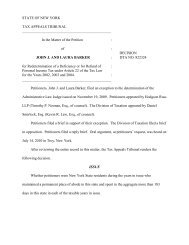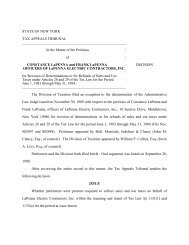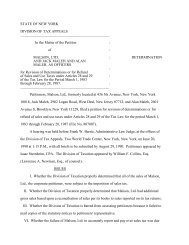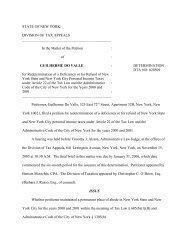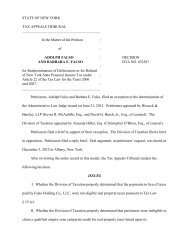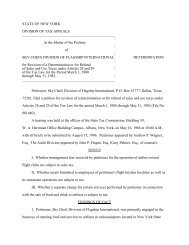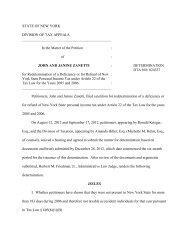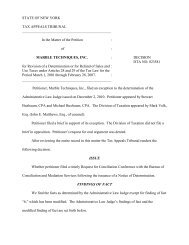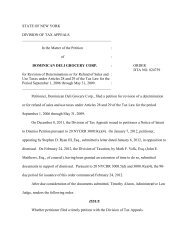In the Matter of the Petition - Tax Appeals Tribunal
In the Matter of the Petition - Tax Appeals Tribunal
In the Matter of the Petition - Tax Appeals Tribunal
Create successful ePaper yourself
Turn your PDF publications into a flip-book with our unique Google optimized e-Paper software.
STATE OF NEW YORK<br />
TAX APPEALS TRIBUNAL<br />
________________________________________________<br />
<strong>In</strong> <strong>the</strong> <strong>Matter</strong> <strong>of</strong> <strong>the</strong> <strong>Petition</strong> :<br />
<strong>of</strong> :<br />
RONALD K. AND MAXINE H. LINDE<br />
for Redetermination <strong>of</strong> a Deficiency or for Refund <strong>of</strong> :<br />
Personal <strong>In</strong>come <strong>Tax</strong> under Article 22 <strong>of</strong> <strong>the</strong> <strong>Tax</strong><br />
Law for <strong>the</strong> Year 2005.<br />
:<br />
________________________________________________<br />
:<br />
DECISION<br />
DTA NO. 823300<br />
<strong>Petition</strong>ers, Ronald K. and Maxine H. Linde, filed an exception to <strong>the</strong> determination <strong>of</strong> <strong>the</strong><br />
Administrative Law Judge issued on July 21, 2011. <strong>Petition</strong>ers appeared pro se. The Division <strong>of</strong><br />
<strong>Tax</strong>ation appeared by Mark Volk, Esq. (Christopher O’Brien, Esq., <strong>of</strong> counsel).<br />
<strong>Petition</strong>ers filed a brief in support <strong>of</strong> <strong>the</strong>ir exception. The Division <strong>of</strong> <strong>Tax</strong>ation filed a brief<br />
in opposition. <strong>Petition</strong>ers filed a reply brief. Oral argument was not requested.<br />
After reviewing <strong>the</strong> entire record in this matter, <strong>the</strong> <strong>Tax</strong> <strong>Appeals</strong> <strong>Tribunal</strong> renders <strong>the</strong><br />
following decision.<br />
ISSUE<br />
Whe<strong>the</strong>r income realized as a result <strong>of</strong> <strong>the</strong> sale by a nonresident partnership <strong>of</strong> real property<br />
located in New York is properly allocated solely to New York State.<br />
FINDINGS OF FACT<br />
We find <strong>the</strong> facts as determined by <strong>the</strong> Administrative Law Judge. These facts are set forth<br />
below.
-2<br />
During <strong>the</strong> year 2005, petitioners, Ronald K. and Maxine H. Linde, were residents <strong>of</strong> <strong>the</strong><br />
state <strong>of</strong> Arizona. For <strong>the</strong> tax year 2005, petitioners filed a joint New York State Nonresident and<br />
Part-Year Resident <strong>In</strong>come <strong>Tax</strong> Return. During <strong>the</strong> year at issue, petitioners were partners in<br />
Strategic Hotel Capital, LLC (Strategic), which was headquartered in and managed from<br />
Chicago, Illinois. <strong>In</strong>cluded in petitioners’ income for <strong>the</strong> year 2005 were partnership<br />
distributions received from Strategic.<br />
The business <strong>of</strong> Strategic was <strong>the</strong> purchase, renovation and management <strong>of</strong> hotel properties<br />
with <strong>the</strong> ultimate objective <strong>of</strong> selling <strong>the</strong> properties at a gain. Strategic owned hotels in several<br />
states, including New York. When Strategic acquired a hotel, it usually renovated <strong>the</strong> hotel and<br />
furnishings to enhance <strong>the</strong> quality <strong>of</strong> <strong>the</strong> hotel, <strong>the</strong>reby increasing its usage, rates and value.<br />
Strategic purchased <strong>the</strong> Marriott East Side Hotel on March 4, 1998 and <strong>the</strong> Essex House<br />
Hotel on March 12, 1999, both located in New York City. Each hotel was subsequently<br />
renovated. Strategic included <strong>the</strong> costs <strong>of</strong> maintaining <strong>the</strong> hotels plus <strong>the</strong> associated depreciation<br />
deductions in <strong>the</strong> calculation <strong>of</strong> its operating income from <strong>the</strong> operations <strong>of</strong> <strong>the</strong> hotels. Strategic<br />
allocated <strong>the</strong> operating income from all <strong>of</strong> its hotels to New York by using <strong>the</strong> three-factor<br />
business allocation percentage.<br />
Over <strong>the</strong> years, most <strong>of</strong> Strategic’s income had been <strong>the</strong> result <strong>of</strong> gains from <strong>the</strong> sale <strong>of</strong> real<br />
property. During 2005, Strategic sold <strong>the</strong> Marriott East Side and Essex House hotels, as well as<br />
hotels located in o<strong>the</strong>r states. At <strong>the</strong> time, Strategic had a business plan to divest itself <strong>of</strong> all<br />
remaining hotel properties, and it was completely liquidated in 2009. On its 2005 New York<br />
State partnership return, Form IT-204, Strategic apportioned <strong>the</strong> gains using a business allocation<br />
percentage <strong>of</strong> 16.29. On <strong>the</strong>ir return, petitioners allocated <strong>the</strong> same portion <strong>of</strong> <strong>the</strong> gain derived<br />
from <strong>the</strong> sale <strong>of</strong> <strong>the</strong> two hotels to New York.
-3<br />
Following an audit, <strong>the</strong> Division <strong>of</strong> <strong>Tax</strong>ation (Division) determined that Strategic did not<br />
properly allocate New York source income to its partners. The income at issue was <strong>the</strong> sale <strong>of</strong><br />
<strong>the</strong> two hotel properties located in New York City. It was <strong>the</strong> position <strong>of</strong> <strong>the</strong> Division that <strong>the</strong><br />
entire gains should have been allocated to New York, as <strong>the</strong> situs <strong>of</strong> <strong>the</strong> hotel properties was in<br />
New York.<br />
On September 21, 2009, <strong>the</strong> Division issued to petitioners a Notice <strong>of</strong> Deficiency<br />
(assessment number L-032511120-6) for personal income tax due <strong>of</strong> $51,169.00, plus interest.<br />
THE DETERMINATION OF THE ADMINISTRATIVE LAW JUDGE<br />
The Administrative Law Judge determined that for an individual partner <strong>of</strong> a partnership<br />
who is nonresident <strong>of</strong> New York State, where <strong>the</strong> partnership does business both within and<br />
outside <strong>of</strong> <strong>the</strong> State, <strong>the</strong> New York portion <strong>of</strong> partnership income is generally determined by <strong>the</strong><br />
partnership’s business in New York that is based upon a business allocation percentage<br />
determined by <strong>the</strong> business activity <strong>of</strong> <strong>the</strong> partnership both within and without <strong>of</strong> New York. The<br />
Administrative Law Judge also found that <strong>the</strong> <strong>Tax</strong> Law includes an exception to that general rule<br />
in that, pursuant to 20 NYCRR 132.16, gains and losses from <strong>the</strong> sale <strong>of</strong> real property are not<br />
subject to application <strong>of</strong> <strong>the</strong> partnership’s business allocation percentage, but instead are<br />
allocated entirely to <strong>the</strong> state where <strong>the</strong> sold real property is located.<br />
The Administrative Law Judge found that <strong>the</strong> Division’s interpretation <strong>of</strong> <strong>the</strong> law that <strong>the</strong><br />
entire gain from <strong>the</strong> sale <strong>of</strong> real property located within New York State should be allocated<br />
entirely to New York was nei<strong>the</strong>r irrational nor unreasonable and is wholly consistent with <strong>the</strong><br />
<strong>Tax</strong> Law.<br />
Fur<strong>the</strong>rmore, <strong>the</strong> Administrative Law Judge distinguished <strong>the</strong> various cases cited by<br />
petitioners from <strong>the</strong> present matter and noted that none <strong>of</strong> <strong>the</strong> cited cases involve <strong>the</strong> allocation <strong>of</strong>
-4<br />
<strong>the</strong> proceeds <strong>of</strong> <strong>the</strong> sale <strong>of</strong> real property located in New York State but instead dealt with issues<br />
that were not analogous to this controversy.<br />
The Administrative Law Judge found that petitioners’ position that <strong>the</strong>y are entitled to <strong>the</strong><br />
waiver <strong>of</strong> all interest is without merit and that petitioners had presented no evidence to support an<br />
abatement <strong>of</strong> interest.<br />
As a result <strong>of</strong> his findings, <strong>the</strong> Administrative Law Judge denied <strong>the</strong> petition and sustained<br />
<strong>the</strong> relevant Notice <strong>of</strong> Deficiency.<br />
ARGUMENTS ON EXCEPTION<br />
<strong>In</strong> <strong>the</strong>ir exception, petitioners make <strong>the</strong> same arguments as made before <strong>the</strong> Administrative<br />
Law Judge. <strong>Petition</strong>ers refer <strong>the</strong> <strong>Tribunal</strong> to <strong>the</strong>ir brief that was submitted to <strong>the</strong> Administrative<br />
Law Judge for support <strong>of</strong> <strong>the</strong>ir exception. Before <strong>the</strong> Administrative Law Judge, petitioners<br />
submitted into evidence a number <strong>of</strong> letters authored by Gregory Bergmann <strong>of</strong> Deloitte <strong>Tax</strong>,<br />
LLP, addressed to ei<strong>the</strong>r <strong>the</strong> petitioners or <strong>the</strong> Division; most <strong>of</strong> petitioners’ analysis and<br />
arguments before <strong>the</strong> Administrative Law Judge, and this <strong>Tribunal</strong>, were performed in <strong>the</strong><br />
Deloitte <strong>Tax</strong>, LLP letters.<br />
On exception, petitioners contend that 20 NYCRR 132.16, when read toge<strong>the</strong>r with 20<br />
NYCRR 132.15, is limited to gains derived from <strong>the</strong> sale <strong>of</strong> rental property, which <strong>the</strong> subject<br />
hotels were not. <strong>Petition</strong>ers argue that according to 20 NYCRR 132.15 (a), if a nonresident<br />
individual, or a partnership <strong>of</strong> which a nonresident individual is a member, carries on a business<br />
both within and without <strong>of</strong> New York State, unless <strong>the</strong> subject property is rental property, <strong>the</strong><br />
gain attributable to <strong>the</strong> sale <strong>of</strong> real property must be apportioned and allocated to New York State<br />
on a proportional basis utilizing petitioners’ business allocation percentage. Fur<strong>the</strong>rmore,<br />
petitioners argue that <strong>the</strong> Division’s application <strong>of</strong> <strong>the</strong> relevant <strong>Tax</strong> Law and regulations violates
-5<br />
<strong>the</strong> Privileges and Immunities Clause and <strong>the</strong> Commerce Clause <strong>of</strong> <strong>the</strong> United States<br />
Constitution.<br />
<strong>In</strong> response, <strong>the</strong> Division requests that <strong>the</strong> <strong>Tribunal</strong> uphold <strong>the</strong> Administrative Law Judge’s<br />
determination; <strong>the</strong> Division also <strong>of</strong>fered certain limited analysis <strong>of</strong> <strong>the</strong> constitutional claims.<br />
OPINION<br />
New York State imposes personal income tax on <strong>the</strong> income <strong>of</strong> nonresident individuals to<br />
<strong>the</strong> extent that <strong>the</strong>ir income is derived from or connected to New York sources (<strong>Tax</strong> Law § 601<br />
[e]). <strong>In</strong>cluded in such income is that which is attributable to a business, trade, pr<strong>of</strong>ession or<br />
occupation carried on in New York State (<strong>Tax</strong> Law § 631 [b] [1] [B]). As <strong>the</strong> Court <strong>of</strong> <strong>Appeals</strong><br />
stated:<br />
“Although a state may tax all <strong>the</strong> income <strong>of</strong> its residents, even income earned<br />
outside <strong>the</strong> taxing jurisdiction, it may constitutionally tax nonresidents only on<br />
<strong>the</strong>ir income derived from sources within <strong>the</strong> state (see Shaffer v. Carter, 252 U.S.<br />
37, 57 [1920]). <strong>In</strong> New York, <strong>the</strong> income <strong>of</strong> nonresidents is thus taxed by <strong>the</strong> State<br />
if it is ‘derived from or connected with New York sources’ (see <strong>Tax</strong> Law §§ 601<br />
[e] [1]; 631 [a] [1]).[footnote omitted] New York source income includes income<br />
attributable to a business, trade, pr<strong>of</strong>ession or occupation carried on in this State<br />
(see <strong>Tax</strong> Law § 631 [b] [1] [B])” (<strong>Matter</strong> <strong>of</strong> Zelinsky v <strong>Tax</strong> <strong>Appeals</strong> Trib. <strong>of</strong><br />
State <strong>of</strong> N.Y., 1 NY3d 85, 89-90 [2003], cert denied 541 US 1009 [2004]).<br />
If a taxpayer’s business, trade, pr<strong>of</strong>ession or occupation is carried on partly within and<br />
partly without this State, <strong>the</strong> items <strong>of</strong> income, gain, loss and deduction derived from or connected<br />
with New York sources shall be determined by apportionment and allocation under such<br />
regulations (<strong>Matter</strong> <strong>of</strong> Schibuk v New York State <strong>Tax</strong> <strong>Appeals</strong> Trib., 289 AD2d 718 [2001], lv<br />
dismissed 98 NY2d 720 [2002], rearg denied 99 NY2d 554 [2002]).<br />
The New York source income <strong>of</strong> a nonresident individual includes <strong>the</strong> sum <strong>of</strong> <strong>the</strong> net<br />
amount <strong>of</strong> items <strong>of</strong> income, gain, loss and deduction entering into <strong>the</strong> individual’s federal
-6<br />
adjusted gross income “derived from or connected with New York sources, including: (A) his<br />
distributive share <strong>of</strong> partnership income, gain, loss and deduction, determined under [<strong>Tax</strong> Law]<br />
section six hundred thirty-two . . .” (<strong>Tax</strong> Law § 631 [a] [1]). The New York source income <strong>of</strong> a<br />
nonresident partner includes his distributive share <strong>of</strong> all items <strong>of</strong> partnership income, gain, loss<br />
and deduction entering into his federal adjusted gross income to <strong>the</strong> extent such items are derived<br />
from or connected with New York sources (<strong>Tax</strong> Law § 632 [a] [1]).<br />
The New York source <strong>of</strong> partnership income is determined by <strong>the</strong> partnership’s business<br />
in New York, with <strong>the</strong> allocation percentage determined by <strong>the</strong> business activity <strong>of</strong> <strong>the</strong><br />
partnership within and outside <strong>of</strong> New York, calculated by <strong>the</strong> partnership’s business allocation<br />
percentage (or as calculated by an alternative method authorized by <strong>the</strong> Division).<br />
The business allocation percentage results from <strong>the</strong> three percentages <strong>of</strong> partnership<br />
property, partnership payroll and partnership gross income (20 NYCRR 132.15 [d], [e], [f]).<br />
However, pursuant to 20 NYCRR 132.16, income and deductions connected with <strong>the</strong> rental <strong>of</strong><br />
real property and gain and loss from <strong>the</strong> sale or exchange <strong>of</strong> real property are not subject to<br />
allocation, but are considered as entirely derived from <strong>the</strong> situs <strong>of</strong> <strong>the</strong> real property.<br />
<strong>Petition</strong>ers argue that, in conjunction with discussing <strong>the</strong> recognition <strong>of</strong> income and<br />
losses, <strong>Tax</strong> Law § 632 (a) (1) includes <strong>the</strong> limiting words “only <strong>the</strong> portion,” and 20 NYCRR<br />
132.15 (a) includes <strong>the</strong> limiting words “apportioned and allocated to New York” along with <strong>the</strong><br />
reference to “items <strong>of</strong> income, gain, loss and deduction attributable to such business.”<br />
<strong>Petition</strong>ers assert that when 20 NYCRR 132.16 is read in conjunction with both <strong>Tax</strong> Law § 632<br />
(a) (1) and 20 NYCRR 132.15, <strong>the</strong> sourcing <strong>of</strong> income, deductions, gains and losses referred to
-7<br />
in 20 NYCRR 132.16 must be limited to only those derived from rental property. 1 We find that<br />
petitioners are attempting to read language that does not exist into 20 NYCRR 132.16.<br />
Fur<strong>the</strong>rmore, we find that <strong>the</strong> language <strong>of</strong> 20 NYCRR 132.16 is clear as written and that <strong>the</strong><br />
vague language found in <strong>Tax</strong> Law § 632 (a) (1) and 20 NYCRR 132.15 does not prohibit <strong>the</strong><br />
approach that is advanced by <strong>the</strong> Division and is in fact prescribed by 20 NYCRR 132.16.<br />
Accordingly, we hold that <strong>the</strong> Division correctly interpreted 20 NYCRR 132.16 as requiring that<br />
<strong>the</strong> gains from <strong>the</strong> sale or exchange <strong>of</strong> real property are to be considered as entirely derived from<br />
<strong>the</strong> situs <strong>of</strong> <strong>the</strong> real property.<br />
<strong>Petition</strong>ers cite to certain cases to support <strong>the</strong>ir position that <strong>the</strong> sourcing <strong>of</strong> gains from<br />
<strong>the</strong> sale <strong>of</strong> real property is not determined solely by <strong>the</strong> location <strong>of</strong> <strong>the</strong> property. Specifically,<br />
petitioners cite <strong>Matter</strong> <strong>of</strong> Ausbrooks v Chu (66 NY2d 281 [1985]); <strong>Matter</strong> <strong>of</strong> Vogt v. Tully (53<br />
NY2d 580[1981]); <strong>Matter</strong> <strong>of</strong> Domber v <strong>Tax</strong> <strong>Appeals</strong> Trib. <strong>of</strong> State <strong>of</strong> N.Y. (210 AD2d 529<br />
[1994], lv denied, 85 NY2d 810 [1995]) and <strong>Matter</strong> <strong>of</strong> Domber v <strong>Tax</strong> <strong>Appeals</strong> Trib. (263 AD2d<br />
277 [2000], lv denied 95 NY2d 760 [2000]). The Administrative Law Judge accurately pointed<br />
out <strong>the</strong> differences between <strong>the</strong> cases cited by petitioners and <strong>the</strong> case at hand, and thus those<br />
cases have little bearing on this case. 2<br />
<strong>Petition</strong>ers also argue that <strong>the</strong> current application <strong>of</strong> 20 NYCRR 132.16 is<br />
unconstitutional under both <strong>the</strong> Commerce Clause and <strong>the</strong> Privileges and Immunities Clause <strong>of</strong><br />
<strong>the</strong> United States Constitution in that 20 NYCRR 132.16 allegedly discriminates against: (i)<br />
1 Nei<strong>the</strong>r party in this case claims that <strong>the</strong> Strategic properties in question are rental properties.<br />
2<br />
<strong>In</strong>terestingly, in Domber v <strong>Tax</strong> <strong>Appeals</strong> Trib. <strong>of</strong> State <strong>of</strong> N.Y. (210 AD2d 529 [1994], lv denied, 85<br />
NY2d 810 [1995]) <strong>the</strong> court indicated that in fact, for purposes <strong>of</strong> <strong>the</strong> application <strong>of</strong> 20 NYCRR 132.16, <strong>the</strong>re is a<br />
distinction between income generated by (i) <strong>the</strong> rental <strong>of</strong> real property and (ii) real estate sales gains. This<br />
recognized distinction fur<strong>the</strong>r supports <strong>the</strong> Division’s position in this matter.
-8<br />
nonresident New York individual partners as opposed to resident New York individual partners,<br />
and (ii) all individual partners as opposed to corporate partners.<br />
As <strong>the</strong> Court <strong>of</strong> <strong>Appeals</strong> noted:<br />
“Although <strong>the</strong> dormant Commerce Clause limits <strong>the</strong> power <strong>of</strong> states to erect<br />
barriers against interstate trade, a challenged tax will generally satisfy<br />
constitutional requirements if it ‘is applied to an activity with a substantial nexus<br />
with <strong>the</strong> taxing State, is fairly apportioned, does not discriminate against interstate<br />
commerce, and is fairly related to <strong>the</strong> services provided by <strong>the</strong> State’ (Complete<br />
Auto Tr., <strong>In</strong>c. v. Brady, 430 U.S. 274, 279 [1977])” (<strong>Matter</strong> <strong>of</strong> Zelinsky v <strong>Tax</strong><br />
<strong>Appeals</strong> Trib. <strong>of</strong> State <strong>of</strong> N.Y., 1 NY3d 85, 90 [2003], cert denied 541 US 1009<br />
[2004]).<br />
Here, petitioners challenge only <strong>the</strong> third prong <strong>of</strong> this four-part Commerce Clause test,<br />
and assert that <strong>the</strong> combined effects <strong>of</strong> 20 NYCRR 132.15 and 20 NYCRR 132.16 discriminate<br />
against interstate commerce. The remaining three criteria are not disputed by petitioners. 3<br />
Pursuant to 20 NYCRR 132.16, parties are taxed on <strong>the</strong> full amount <strong>of</strong> <strong>the</strong> gain realized<br />
on <strong>the</strong> sale <strong>of</strong> real property located within New York State, regardless <strong>of</strong> whe<strong>the</strong>r <strong>the</strong>y are<br />
resident or nonresident individual partners. The Division’s application <strong>of</strong> 20 NYCRR 132.16 is<br />
exactly <strong>the</strong> same as to resident and nonresident individual partners; that is, <strong>the</strong> tax regulation at<br />
issue is an “evenhanded” regulation (see Oregon Waste Systems, <strong>In</strong>c. v Department <strong>of</strong><br />
Environmental Quality <strong>of</strong> Ore., 511 US 93 [1994]) and is completely tax neutral on its face.<br />
Fur<strong>the</strong>rmore, 20 NYCRR 132.16 addresses a certain very specific type <strong>of</strong> gain, that is, <strong>the</strong> gain<br />
derived from <strong>the</strong> sale <strong>of</strong> real property. 4 <strong>In</strong> contrast, 20 NYCRR 132.15 addresses <strong>the</strong> accounting<br />
3 Although petitioners desire to have 20 NYCRR 132.16 applied in such a way as to require <strong>the</strong><br />
apportionment <strong>of</strong> gains from <strong>the</strong> sale <strong>of</strong> real property between within and without <strong>of</strong> <strong>the</strong> State, petitioners do not<br />
assert that <strong>the</strong> allocation <strong>of</strong> all <strong>of</strong> <strong>the</strong> gains from <strong>the</strong> sale <strong>of</strong> real property located within New York to <strong>the</strong> State is<br />
independently a violation <strong>of</strong> <strong>the</strong> fair apportionment, or any o<strong>the</strong>r, requirement <strong>of</strong> <strong>the</strong> Commerce Clause.<br />
4 As noted, 20 NYCRR 132.16 also addresses <strong>the</strong> sourcing <strong>of</strong> income and losses attributed to rental<br />
property operations but such is not germane to this analysis.
-9<br />
for income, gains and losses from o<strong>the</strong>r business operations. On its face, 20 NYCRR 132.16<br />
does not discriminate between resident and nonresident individual partners. <strong>Petition</strong>ers claim<br />
that nonresident individual partners are treated differently from <strong>the</strong>ir resident counterparts, in that<br />
<strong>the</strong> nonresidents are not able to fully utilize <strong>the</strong> depreciation deductions from business operations<br />
because such are allocated as between New York and non-New York sources pursuant to 20<br />
NYCRR 132.15. 5 <strong>Petition</strong>ers assert that this creates a potential detriment to nonresident<br />
individuals because in <strong>the</strong> nonresidents’ respective gain calculation under 20 NYCRR 132.16,<br />
nonresidents take into account all <strong>of</strong> <strong>the</strong> accumulated depreciation, but <strong>the</strong>se nonresident<br />
individuals received a deduction only for an allocated portion <strong>of</strong> such depreciation. 6, 7<br />
<strong>Petition</strong>ers assert that although resident individual partners have <strong>the</strong> same gain calculation, such<br />
partners were able to fully utilize <strong>the</strong> depreciation deductions that make up <strong>the</strong> accumulated<br />
depreciation component <strong>of</strong> <strong>the</strong> gain calculation.<br />
We hold that any differences in depreciation utilization, which are not incorporated into<br />
<strong>the</strong> calculation <strong>of</strong> <strong>the</strong> basis for <strong>the</strong> real property sold, shall be properly remedied by an adjustment<br />
by <strong>the</strong> Division to petitioners’ basis, such that <strong>the</strong> basis calculation takes into account only <strong>the</strong><br />
depreciation for which <strong>the</strong> nonresident individual partners previously received a benefit. Upon<br />
adjustment to petitioners’ and o<strong>the</strong>r nonresident individual partners’ basis, 20 NYCRR 132.16<br />
treats resident and nonresident individual partners alike in all respects and does not discriminate<br />
between such parties.<br />
5 <strong>Petition</strong>ers do not challenge <strong>the</strong> constitutionality <strong>of</strong> <strong>the</strong> allocation <strong>of</strong> income and expenses required<br />
pursuant to 20 NYCRR 132.15.<br />
6 Nonresident individual partners may also be able to benefit substantially from a tax perspective from <strong>the</strong><br />
allocation <strong>of</strong> operating business income as compared to resident individual partners, where no allocation <strong>of</strong> such<br />
income is performed.<br />
7 <strong>In</strong> its brief, <strong>the</strong> Division does not address <strong>the</strong> petitioners’ depreciation argument in any detail.
-10<br />
“Like <strong>the</strong> Commerce Clause, <strong>the</strong> Privileges and Immunities Clause derives from<br />
<strong>the</strong> fourth article <strong>of</strong> <strong>the</strong> Articles <strong>of</strong> Confederation and was promulgated to create a<br />
national economic union, with one citizenry, by placing <strong>the</strong> citizens <strong>of</strong> each State<br />
on equal footing with citizens <strong>of</strong> o<strong>the</strong>r States, as far as <strong>the</strong> advantages resulting<br />
from citizenship in those States are concerned (see, Supreme Court <strong>of</strong> New<br />
Hampshire v. Piper, 470 U.S. 274, 279-280). The goal was to insure that <strong>the</strong> union<br />
<strong>of</strong> States would provide an economic system that would work to benefit all<br />
citizens <strong>of</strong> <strong>the</strong> union (see, The Federalist No. 7, at 61 [Alexander Hamilton]<br />
[Clinton Rossiter ed. 1961]). . .<br />
The Privileges and Immunities Clause is not absolute (Toomer v. Witsell, 334<br />
U.S. 385, 396), and affords no assurance <strong>of</strong> precise equality in taxation between<br />
residents and nonresidents <strong>of</strong> a particular State (Lunding et ux. v. New York State<br />
<strong>Tax</strong> <strong>Appeals</strong> <strong>Tribunal</strong>, et al., 522 U.S. 287, 297). <strong>In</strong>stead, <strong>the</strong> Clause requires a<br />
standard <strong>of</strong> ‘substantial equality <strong>of</strong> treatment’ for <strong>the</strong> citizens <strong>of</strong> <strong>the</strong> taxing State<br />
and nonresident taxpayers (Austin v. New Hampshire, 420 U.S. 656, 665)”(City<br />
<strong>of</strong> New York v State <strong>of</strong> New York, 94 NY2d 577, 592-593 [2000]).<br />
As analyzed above, <strong>the</strong> regulation in question does not discriminate against nonresident<br />
individual partners, and thus does not violate <strong>the</strong> Privileges and Immunities Clause <strong>of</strong> <strong>the</strong> United<br />
States Constitution as claimed by petitioners.<br />
<strong>Petition</strong>ers’ second constitutional claim is that <strong>the</strong> Division’s application <strong>of</strong> <strong>the</strong> regulation<br />
in question discriminates unconstitutionally against all individual partners as opposed to<br />
corporate partners. Such a claim challenges <strong>the</strong> constitutionality <strong>of</strong> <strong>the</strong> law on its face. We reject<br />
this claim and note that <strong>the</strong> Division <strong>of</strong> <strong>Tax</strong> <strong>Appeals</strong> lacks jurisdiction over constitutional<br />
challenges to statutes, which are presumed to be constitutional on <strong>the</strong>ir face (see <strong>Matter</strong> <strong>of</strong><br />
Eisenstein, <strong>Tax</strong> <strong>Appeals</strong> <strong>Tribunal</strong>, March 27, 2003; see also <strong>Matter</strong> <strong>of</strong> Geneva Pennysaver, <strong>Tax</strong><br />
<strong>Appeals</strong> <strong>Tribunal</strong>, September 11, 1989; <strong>Matter</strong> <strong>of</strong> Fourth Day Enters., <strong>Tax</strong> <strong>Appeals</strong> <strong>Tribunal</strong>,<br />
October 27, 1988). 8 Accordingly, while we have jurisdiction to consider constitutional<br />
8 We do note that <strong>the</strong> United States Supreme Court articulated that:<br />
“As a general rule, ‘legislatures are presumed to have acted within <strong>the</strong>ir constitutional power<br />
despite <strong>the</strong> fact that, in practice, <strong>the</strong>ir laws result in some inequality.’ McGowan v. Maryland, 366<br />
U.S. 420, 425-426 (1961). Accordingly, this Court's cases are clear that, unless a classification<br />
warrants some form <strong>of</strong> heightened review because it jeopardizes exercise <strong>of</strong> a fundamental right or
-11<br />
challenges (“as applied”) to <strong>the</strong> actions <strong>of</strong> <strong>the</strong> Division <strong>of</strong> <strong>Tax</strong>ation, we do not have jurisdiction<br />
to consider this particular argument advanced by petitioners. <strong>Petition</strong>ers will not be denied a<br />
resolution <strong>of</strong> this constitutional claim if <strong>the</strong>y bring an Article 78 proceeding to review this<br />
decision before <strong>the</strong> Appellate Division, Third Department.<br />
Accordingly, it is ORDERED, ADJUDGED and DECREED that:<br />
1. The exception <strong>of</strong> Ronald K. and Maxine H. Linde is denied;<br />
2. The determination <strong>of</strong> <strong>the</strong> Administrative Law Judge is affirmed as adjusted herein;<br />
3. The petitions <strong>of</strong> Ronald K. and Maxine H. Linde are denied; and<br />
4. After accounting for <strong>the</strong> adjustment to <strong>the</strong> petitioners’ basis as noted herein, <strong>the</strong> Notice<br />
<strong>of</strong> Deficiency dated September 21, 2009 is sustained.<br />
DATED: Albany, New York<br />
May 24, 2012<br />
/s/ James H. Tully, Jr.<br />
James H. Tully, Jr.<br />
President<br />
/s/ Charles H. Nesbitt<br />
Charles H. Nesbitt<br />
Commissioner<br />
categorizes on <strong>the</strong> basis <strong>of</strong> an inherently suspect characteristic, <strong>the</strong> Equal Protection Clause<br />
requires only that <strong>the</strong> classification rationally fur<strong>the</strong>r a legitimate state interest. See, e. g., Cleburne<br />
v. Cleburne Living Center, <strong>In</strong>c., 473 U.S. 432, 439-441 (1985); New Orleans v. Dukes, 427 U.S.<br />
297, 303 (1976).” (Nordlinger v Hahn, 505 US 1, 10 [1992]).




